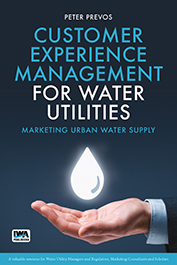Introducing Water Utility Marketing: Using Social Science to Create Customer Value
By Dr Peter Prevos, author of Customer Experience Management for Water Utilities
Water utilities are part of the backbone of society because tap water is one of the most effective ways to maintain public health. Providing reliable tap water that is safe to drink is an essential service that water utilities provide to communities. Utilities provide safe and reliable drinking water to their communities at a level of quality that is so high that global taxi business Uber stated in their strategy that they want to provide “transportation that is as reliable as running water”.
Providing such a high level of service requires the use of science, technology, engineering and mathematics (STEM) to ensure water is safe to drink and available when consumers need it. This approach ensures a high level of quality but focusing on STEM can weaken the relationship between water utilities and their customers. While utilities describe the value of water numerically in cubic meters, milligrams per litre, and so on, customers describe the value of water through their qualitative experience. This difference in perspective can lead to tensions between utilities and their customers. This potential tension teaches us that while technology is a necessary condition to ensure that customers are provided with great value, it is not a sufficient condition. Water professionals need to enhance the traditional STEM approach with the social sciences and more specifically, the science and practice of marketing, to maximise value to customers.
Government regulators, academics and community groups have often criticised water utilities for not being focused on their customers. Australian marketing expert Russel Howcroft even called water utilities “Lazy marketers”. What does Howcroft mean by this statement? Is he correct or is he a bit too harsh? What does marketing have to do with managing a monopolistic service such as tap water?
Most people view marketing in the limited sense of promotion and advertising. We are annoyed by intrusive advertising or marketing gimmicks that sell us things we do not need. Marketing can, however, also be a force that improves society. Theories of marketing have over the past decades evolved to become more inclusive of non-commercial activities. The American Marketing Association defines marketing as “the activity, set of institutions, and processes for creating, communicating, delivering, and exchanging offerings that have value for customers, clients, partners, and society at large.”
This contemporary definition is more suitable to water utilities than the traditional narrow view of marketing as advertising and the selling of goods and services. Contemporary marketing theory provides a different perspective on the activities of water utilities that enhances the traditional STEM approach by adding a social dimension to all aspects of service provision. The new marketing approach increases the value water utilities provide to society at large, which aligns with the place that water utilities have as public service providers.
My book Customer Experience Management for Water Utilities is based on five years of research and extensive experience with managing various aspects of water utilities. This book discusses marketing theory from the perspective of water utilities. My aim for writing this book is to inspire water utility managers to think differently about their day-to-day activities by providing a framework based on marketing theory.
My greatest challenge with writing this book was that standard models for marketing are not suitable to monopolistic water utilities without modification. My book thus presents a marketing mix tailored to water utilities, which includes value propositions, internal marketing, service quality and customer relationships.
The book discusses the four dimensions of this bespoke marketing mix in some detail. The first two chapters discuss how marketing theory relates to water utilities. Chapter three presents a template for developing value propositions to assist water utilities in positioning their service. This model is based on the needs and wants of individual customer segments and the type of service. Chapter four discusses internal marketing, which are activities to improve the way utility employees add value for customers. This chapter also analyses potential tensions between engineering and science-oriented employees and proposes methods to resolve these tensions. The following chapter describes customer relationships from both a theoretical and practical perspective. The customer experience is a complex phenomenon that is difficult to quantify. The book also provides a method to measure the experience of the customer, based on service quality theory and psychometric statistics.
This article presents topics covered in chapter one of Customer Experience Management for Water Utilities (© 2018 IWA Publishing) which is available now. If you like to know more about how to apply marketing theory to your work, then you should think about purchasing this book from IWA publishing. It will will inspire you to think differently about urban water services and will help you to make decisions that maximise value for customers.
